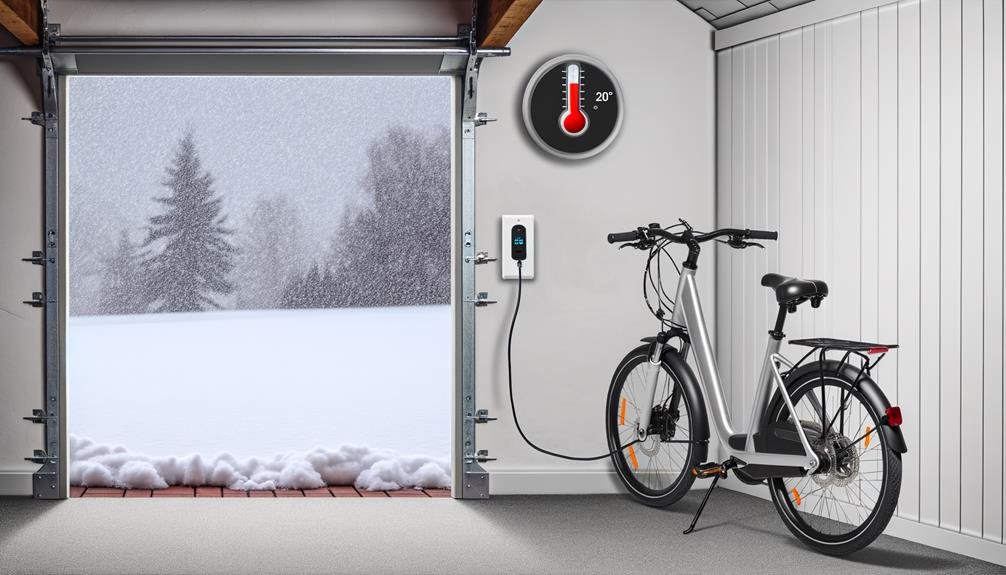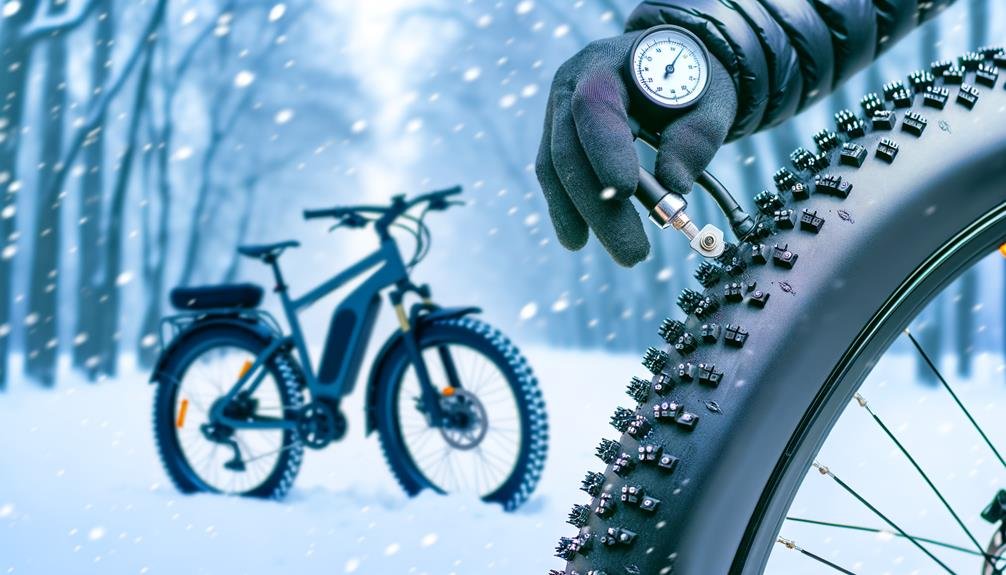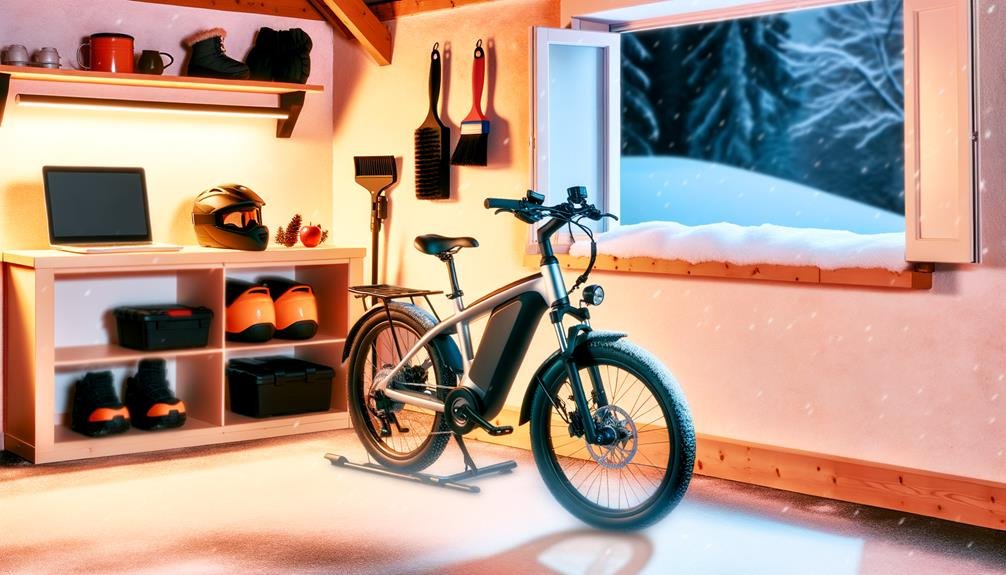Charles Miller is a veteran bike enthusiast with over 12 years of experience dealing with bikes as a mechanic. Despite immense love and expertise for...
Battling a torrent of snow on an electric bike sounds like an epic saga straight out of an adventure novel, doesn't it? Now, we're not suggesting that you brave a blizzard, but we'd like to explore the intriguing prospect of riding an electric bike in the snow.
Can it be done? Absolutely. But hold your horses – or rather, your handlebars. It's not as simple as hopping on and powering through the snowflakes. There are precautions you need to take, adjustments to make, and even some surprising benefits to uncover.
So, shall we begin our frosty journey into the world of snowy e-biking?
- Key Takeaways
- Understanding E-Bike Winter Limitations
- Route Planning for Snowy Conditions
- Proper E-Bike Charging in Winter
- Importance of E-Bike Cleanliness
- Checking Tires for Winter Riding
- Safe Winter E-Bike Riding Techniques
- Essential Winter E-Bike Accessories
- Storing Your E-Bike in Winters
- Best E-Bikes for Snowy Conditions
- Frequently Asked Questions
- Conclusion
Key Takeaways
- Proper maintenance and care of e-bike components, including battery, is essential for winter riding.
- Route planning should prioritize safety and consider alternative routes and bike lane conditions.
- Charging and storing the battery at room temperature, around 50% capacity, helps prolong its lifespan.
- Regular cleaning and maintenance of the e-bike is important to prevent rust and damage caused by snow and salt.
Understanding E-Bike Winter Limitations
Navigating the challenges of riding an e-bike during winter requires a detailed understanding of its limitations, beginning with optimal battery care, regular cleaning, appropriate winter gear, and mindful riding habits.
We've learned that cold weather can drastically reduce the performance of an e-bike battery. Therefore, we must ensure that we're not leaving it outside for long periods and store it around 50% capacity at room temperature.
Regular cleaning is also key to maintain our e-bike's performance. Snow and salty mud can degrade the bike's components, so it's necessary to wipe it down after each ride. Using products specifically designed for e-bikes ensures we're not causing any unintended harm.
As part of the community of electric bike riders, we understand the importance of winter gear and mindful riding. Starting off slow, choosing appropriate tires for winter riding, and adjusting our style for safety are all part of our routine. We equip ourselves with bar mitts, neck gaiters, and ensure proper bike lighting for increased visibility.
Route Planning for Snowy Conditions
When we're braving the winter weather on our e-bikes, thoughtful route planning becomes our crucial ally against snowy conditions. Riding an e-bike in the snow can be a thrilling experience, but it's not without its challenges.
In route planning for snowy conditions, we must consider:
- The condition of bike lanes and prepare alternate routes to avoid paths heavily covered in snow and ice.
- The presence of snow plows and their limited visibility. We should never ride too close to a plow.
- The necessity for longer travel times due to unpredictable winter weather. We must stay vigilant and adjust our route accordingly.
- Our physical limitations and the suitability of our e-bike for a winter ride, considering options like front-wheel drive with studded tires for better traction on icy or snowy roads.
- The potential for snow-covered obstacles and slippery conditions. We need to plan our routes to prioritize safety and minimize risks.
Proper E-Bike Charging in Winter

As we shift our focus to proper e-bike charging in winter, it's crucial to comprehend the significant impact of cold weather on battery performance.
We can't stress enough the importance of protecting your e-bike's battery from the cold, as well as the steps to optimally charge it during these harsh months.
Let's explore effective winter battery care tips and how to prevent potential cold-weather damage to ensure your e-bike's longevity.
Winter Battery Care Tips
In order to enhance your e-bike's performance and lifespan during winter, it's crucial to charge and store the battery at room temperature, especially when facing extreme low temperatures. Cold temperatures can significantly reduce your battery life, so we recommend you bring the battery inside during the chilly winter months.
Here are some winter battery care tips:
- Try to charge the battery around 50% and avoid storing it at full charge to prolong its lifespan.
- Regularly check your battery's charge level to prevent self-discharge.
- Always store your battery in a dry and warm place.
- Clean your e-bike after a snowy ride to prevent rust and damage.
- Adjust your riding style for safer winter rides.
These tips will ensure your e-bike is ready for any winter adventure.
Avoiding Cold-Weather Damage
To prevent cold-weather damage to your e-bike, it's essential to properly charge and store the battery during winter. Riding in winter needs special care, especially when you ride in the snow. The battery should be charged when its temperature is above freezing, and stored indoors during extreme weather conditions.
Here are some additional tips to ensure your electric bike stays in top condition:
| Action | Why | How |
|---|---|---|
| Charge above freezing | Prevents damage | Warm battery before charging |
| Store indoors | Improves performance | Keep in room temperature |
| Avoid full charge storage | Prolongs lifespan | Maintain around 50% charge |
| Regular battery checks | Keeps optimal storage level | Recharge to about 50% |
| Use e-bike specific products | Protects bike | Clean and lubricate with right products |
Importance of E-Bike Cleanliness
Maintaining your e-bike's cleanliness is crucial, especially during winter, as accumulated salt, mud, and snow can cause damage if not promptly removed. We understand that harsh riding conditions can make it challenging to keep your bike in top-notch condition, but it's an essential part of extending your electric bike's lifespan.
Here are some pointers to aid in your winter e-bike cleanliness routine:
- Regularly wipe down your bike after each ride to remove salt, mud, and snow. Using soap can help remove stubborn winter residue.
- Consider using cleaning and lubrication products specifically designed for e-bikes. We recommend kits like the Muc-Off CleanProtectLube.
- Don't forget the battery. Keep the charge at an optimal level and avoid storing it fully charged. In extreme low temperatures, bring it inside if it's removable.
- Equip yourself appropriately. Winter-specific gear like bar mitts, balaclavas, and water-resistant gloves can enhance your riding experience.
- Adjust your riding style for safety. Start off slow, match your speed to your experience, and consider winter-friendly tires.
Checking Tires for Winter Riding

While keeping your e-bike clean during winter is crucial, equally important is ensuring your tires are prepared for the icy and snowy conditions. Part of checking tires for winter riding involves regular inspections for wear and tear. It's essential to maintain optimal tire pressure, adjusting it lower than in the summer to increase traction on snowy and icy roads.
We suggest considering winter-specific bike tires, like studded or fat knobby tires, that provide better grip. A mountain bike with a fat tire could be the key to a safe and enjoyable winter ride.
Here's a handy table to guide you:
| Tire Type | Advantage | Use Case |
|---|---|---|
| Studded Tires | Best for ice | Icy roads |
| Fat Knobby Tires | Good for deep snow | Off-road, heavy snow |
| Regular Tires | Versatile, but less grip | Light snow, clear roads |
| Mountain Bike Tires | Good for uneven terrain | Off-road, hilly terrain |
| Lower Tire Pressure | Better traction | All winter conditions |
Safe Winter E-Bike Riding Techniques
We need to turn our attention now to the critical area of safe winter e-bike riding techniques.
Recognizing the importance of proper e-bike maintenance, selecting appropriate cold weather gear, and mastering the skill of handling slippery surfaces are all essential steps to safe winter rides.
These points, when addressed with care and precision, can greatly increase the safety and enjoyment of our winter e-biking experience.
Proper E-Bike Winter Maintenance
To ensure a safe and enjoyable winter e-bike ride, it's imperative we give attention to proper battery care and adopt appropriate riding techniques.
Proper e-bike winter maintenance is critical to keep riding your e-bike during the frosty months. Here are five key steps to follow:
- Store your bike and remove the battery when not in use, keeping them in a room temperature environment.
- Charge an E-Bike at an optimal temperature, avoiding extreme cold.
- Clean and lubricate your electric bicycle regularly to prevent damage from salt and anti-slip treatments on the roads.
- Check the condition of your tires, opting for studded models for better traction on icy roads.
- Prepare your E-Bike for Winter by protecting the LCD screen and cable connections from rain and snow.
Cold Weather Riding Gear
Having established the importance of meticulous maintenance for e-bike winter rides, let's now focus on the crucial role of appropriate cold-weather gear and safe riding techniques to overcome the challenges of icy landscapes.
Cold weather riding gear, like a sturdy helmet, is extra important when riding an electric bike in snowy conditions. Accidents are more likely due to slippery surfaces and limited visibility, so we can't stress enough the need to wear a helmet. High-visibility clothing and lights on your bike are also useful tips for riding in winter, helping others on the road see you.
Layering clothing that retains warmth yet wicks away sweat will keep you safe and comfortable.
Handling Slippery Surfaces Safely
Navigating slippery surfaces safely requires a shift in our riding techniques during winter, including measured starts, careful consideration of our experience level, and the use of suitable tires and lighting.
When we ride our electric bikes in the snow, here's what we need to keep in mind:
- Modulate our bike's front and rear brake usage to prevent skidding.
- Select winter-appropriate bike tires, such as studded for hard-packed snow, or fat and knobby for softer terrain.
- Ensure our bike's lighting is strong enough for visibility in low-light conditions.
- Start off slow and be mindful of our riding capabilities in harsh weather.
- Dress in water-resistant and insulating gear.
Essential Winter E-Bike Accessories
While we've discussed the importance of proper battery care, cleaning, and safety measures for winter e-biking, it's equally vital to consider the accessories that can significantly enhance your riding experience in the colder months.
Essential winter e-bike accessories cover everything from battery covers that keep your power source at room temperature for a full charge, to winter lights that ensure you're visible in low-light conditions.
Let's not let winter deter us from enjoying our ride electric bike in the snow. Fenders are indispensable to keep slush and dirt from splashing onto you. Insulated handlebar mitts keep your hands warm, enabling better control of your pedal assist. Neoprene shoe covers keep your feet dry and toasty, ensuring comfort and the ability to react swiftly in slippery conditions.
High-visibility gear is also crucial. With shorter days in winter, chances are high you might be riding in darker conditions. Reflective gear ensures you're seen by motorists, thus enhancing your safety.
In essence, these accessories not only provide comfort but also contribute substantially to your safety, making your winter e-biking experience a joy.
Storing Your E-Bike in Winters

Just as we've explored the necessity of winter e-bike accessories, it's equally important to understand how to properly store your e-bike during these frosty months. Those of us who use our e-bike all year know the joys and challenges of Dec and its cold grip. But with the right knowledge, storing your e-bike in winters need not be a daunting task.
Here's a simple guide:
- Don't leave the battery on the bike in freezing conditions. Instead, bring the bike inside to protect it from extreme cold.
- Avoid storing the battery fully charged. It's best to keep it around 50% capacity to prolong its life.
- After a snowy ride, wipe down your electric bike to remove salty mud or snow. Using e-bike specific cleaning products can give it that extra care.
- Consider winter-specific tires and perhaps heat-shrink your cable connections and LCD screen for added protection.
- Dress appropriately for the cold and invest in handy accessories like bar mitts and neck gaiters. They may seem trivial, but trust us, they're lifesavers!
Best E-Bikes for Snowy Conditions
Braving the snow on an e-bike can be quite an adventure, especially when you've got the right gear. If you live in an area where snowy conditions are a year-round reality, choosing the best bike for these conditions is crucial.
Electric bikes with fat tires are a fantastic option, thanks to their superior traction and ability to float on snow. That fat front tire won't let you down when the going gets tough. Mid-drive motors or internally geared hub motors also provide a torque advantage, giving you that extra push when you need it most.
Let's not forget the importance of effective braking. E-bikes with hydraulic brakes offer better power and are easier to maintain in winter, ensuring a safer ride. Additionally, water-resistant features are essential to protect the electrical system from wet conditions.
Frequently Asked Questions
How Cold Is Too Cold for Ebike?
We've found that battery performance significantly drops below freezing. Cold impacts an ebike's efficiency, so we recommend proper maintenance, storage solutions, and winter accessories for protection. Adjusting riding techniques is also crucial during cold weather.
Can You Use Electric Bikes in the Snow?
Yes, we can use electric bikes in the snow. It's crucial to ensure snow traction, upkeep battery performance, wear protective gear, tackle maintenance challenges, and follow safety measures for snowy commutes and winter storage.
Can You Ride Ebike in the Rain or Snow?
We've ridden ebikes in snow, but safety on snowy terrain is crucial. Waterproofing measures and component resilience matter. Frost impacts battery performance while visibility challenges arise. Snow tires' importance can't be overstated.
What Is the Best Ebike for Cold Weather?
We believe the best e-bike for cold weather includes heated handlebars, winter tires, and protective covers. It's crucial to ensure battery performance, use cold-resistant materials, weatherproof accessories, and have insulated storage.
Conclusion
So, can we confidently ride our e-bikes through the frosty winter landscape? Absolutely! With careful route planning, diligent bike maintenance, and the right gear, we can navigate snowy terrains safely.
Just remember, isn't the thrill of conquering the chill worth the extra effort? Let's charge our batteries, dress warmly, and embrace the adventure that winter rides offer.
After all, the joy of e-biking doesn't need to hibernate, even when the snow falls.

Charles Miller is a veteran bike enthusiast with over 12 years of experience dealing with bikes as a mechanic. Despite immense love and expertise for his Tacoma, he rides his Trek Ebike more. Anytime you meet him, you’ll either hear him talking about Bikes, or writing about all things bikes and cars on this blog.
More Posts


